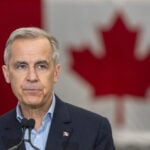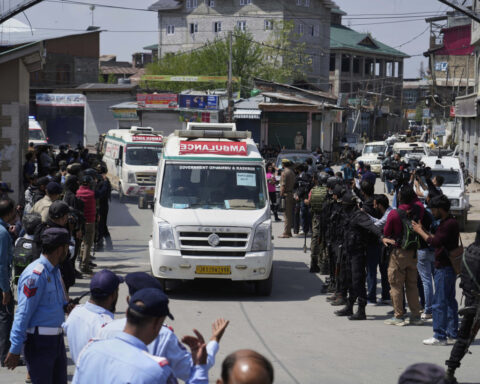By Swati Bhat and Sudipto Ganguly
MUMBAI (Reuters) -The Reserve Bank of India (RBI) lowered its key repo rate on Wednesday for a second consecutive time and changed its monetary policy stance signalling room for more cuts ahead, as it seeks to boost the sluggish economy in the face of fresh U.S. tariffs.
India became the second central bank after the Reserve Bank of New Zealand to cut interest rates since the wide-ranging trade levies were announced.

The tariffs have raised the risk of a global slowdown and a U.S. recession while sparking financial turmoil, leaving emerging market central banks facing a tough choice between cutting rates to support growth and shoring up their fragile currencies.
India's Monetary Policy Committee (MPC), which consists of three RBI and three external members, cut the repo rate by 25 basis points to 6.00% as expected. It started reducing rates with a quarter-point reduction in February, its first cut since May 2020.
The central bank also changed its stance to "accommodative" from "neutral".
The 26% tariffs announced by the U.S. on imports from India have exacerbated uncertainties but quantifying the impact on growth is difficult, central bank Governor Sanjay Malhotra said in his statement.

"Growth is improving after a weak performance in the first half of the financial year 2024-25, although it still remains lower than what we aspire for," said Malhotra, adding that the inflation outlook is benign.
All six MPC members voted to cut the repo rate and change the policy stance.
The change in stance means the MPC is considering only two options, either status quo or a rate cut, and the stance does not directly link to liquidity conditions, he said.
"With uncertainty around U.S. trade policy set to rumble on and inflation looking contained, further rate cuts are likely," said Shilan Shah, deputy chief emerging markets economist at Capital Economics.

"We think the repo rate will drop to 5.50% this year," Shah said in a note.
ANZ Research also expects two more rate cuts and sees these by August 2025.
GROWTH, INFLATION FORECASTS CUT
The RBI now estimates growth at 6.5%, slightly lower than its earlier estimate of 6.7%. It sees inflation at 4% compared to 4.2% earlier.
"In such challenging global economic conditions, the benign inflation and moderate growth outlook demands that the MPC continues to support growth," the committee said in its written statement.
India's benchmark 10-year bond yield was marginally lower at 6.50% after the announcement, against 6.51% before, while the rupee was little changed at 86.57. The benchmark equity indexes extended their losses and were down around 0.6% each.
Economists estimated growth in the world's fifth-largest economy could be hit by 20-40 basis points in the current fiscal year due to the direct and indirect fallout of higher tariffs.
"We see growth undershooting the RBI's estimates and expect it at 6.3% for the fiscal year 2026," Sakshi Gupta, principal economist at HDFC Bank said.
RUPEE WEAKNESS
In an accompanying monetary policy report, the central bank said that rising trade protectionism and threat of currency wars could put further pressure on the rupee.
If the rupee depreciates by 5% over its current assumption of 86 per U.S. dollar, inflation could rise by around 35 bps, though GDP growth could benefit by around 25 bps through the trade channel as exports would become more competitive, the report said.
The central bank's currency management policy will continue to target "excess volatility", Malhotra said. The RBI does not target any level on the rupee but "will not shy from intervening if there is excess volatility," he said.
The rupee has declined 1.2% since the U.S. reciprocal tariffs were announced, largely in line with losses seen in major Asian peers. It hit a record low of 87.95 on February 10.
(Reporting by Swati Bhat and Sudipto Ganguly; additional reporting by Dharamraj Dhutia, Siddhi Nayak and Jaspreet Kalra, Writing by Ira Dugal; Editing by Savio D'Souza and Kim Coghill)

 Trump has begun another trade war. Here's a timeline of how we got here
Trump has begun another trade war. Here's a timeline of how we got here
 Canada's leader laments lost friendship with US in town that sheltered stranded Americans after 9/11
Canada's leader laments lost friendship with US in town that sheltered stranded Americans after 9/11
 Chinese EV giant BYD's fourth-quarter profit leaps 73%
Chinese EV giant BYD's fourth-quarter profit leaps 73%
 You're an American in another land? Prepare to talk about the why and how of Trump 2.0
You're an American in another land? Prepare to talk about the why and how of Trump 2.0
 Chalk talk: Star power, top teams and No. 5 seeds headline the women's March Madness Sweet 16
Chalk talk: Star power, top teams and No. 5 seeds headline the women's March Madness Sweet 16
 Purdue returns to Sweet 16 with 76-62 win over McNeese in March Madness
Purdue returns to Sweet 16 with 76-62 win over McNeese in March Madness







